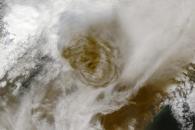
LIBRARY
Natural Disasters: Volcanoes
Volcanoes
Volcanoes are not randomly distributed over the Earth's surface. Most are concentrated on the edges of continents, along island chains, or beneath the sea forming long mountain ranges. More than half of the world's active volcanoes above sea level encircle the Pacific Ocean to form the circum-Pacific "Ring of Fire." In the past 25 years, scientists have developed a theory -- called plate tectonics -- that explains the locations of volcanoes and their relationship to other large-scale geologic features.
From Bradley, 1994, Volcanoes of the United States: USGS General Interest Publication
Print Books in the Library
-
The volcanic earth : volcanoes and plate tectonics, past, present & future by
Call Number: QE522 .S87 1995ISBN: 0868400718"Discusses topics such as plate tectonics, and surveys Australasia's volcanic landforms and their underlying geology. Includes maps, details of areas where volcanic features can be seen..."
Useful Websites
-
US Geological SurveyInclude the largest Earth Sciences library in the world. Latest information about recent earthquakes and other natural disasters.
-
National Geographic Daily NewsIndonesia's Mount Merapi; Japan's Earthquake and Tsunami
-
Eyjafjallajökull, Ash, and Eruption ImpactsLinks to Volcanological Center at the Institute of Earth Sciences, Iceland
-
NASA archive of imagesEyjafjallajokull Volcano in Iceland
-
British Geological SurveyVolcanic eruption in Iceland
-
Smithsonian InstitutionGlobal Volcanism Program
Earth Institute, Columbia University
-
Volcanoes Shift Rainfall PatternsDefying Models, Particles Make Some Regions Drier, Others Wetter
posted: 2010-11-03
Chile 2011

A volcano in the Puyehue-Cordon Caulle chain of south-central Chile erupted June 4 after lying dormant for more than 50 years.
Lightning: Ash particles generate static electricity as they move through the air.
Iceland
-
Iceland VolcanoArticle in ScienceDaily
One year after the eruption of Iceland's volcano Eyjafjajokull closed airports and stranded millions of travelers around Europe, Grimsvotn volcano erupts.
Hawaii
http://volcanoes.usgs.gov/hvo/
Includes maps, images, webcam from the USGS Hawaiian Volcano Observatory


